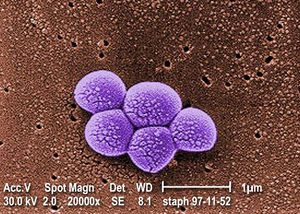|
|
| Line 43: |
Line 43: |
|
| |
|
| ==References== | | ==References== |
|
| |
| <ref name=aa>[https://doi.org/10.1016/S0065-2911(09)05503-9 Peck, M.W. (2009) “Biology and Genomic Analysis of Clostridium botulinum,” Advances in Microbial Physiology. Academic Press.Vol. 55, 183-320. ]</ref>
| |
|
| |
| <ref name=aa>[https://doi.org/10.1016/j.anaerobe.2018.06.015 Xin, W., et al. (2019) “Identification and characterization of Clostridium botulinum strains associated with an infant botulism case in China,” Anaerobe, Vol. 55, 1-7.]</ref>
| |
|
| |
| <ref name=aa>[https://doi.org/10.1016/j.fm.2010.03.005 Peck, M.W., Stringer, S.C., Carter, A.T. (2011) “Clostridium botulinum in the post-genomic era,” Food Microbiology, 28(2), 183-191.]</ref>
| |
|
| |
| <ref name=aa>[https://doi.org/10.1016/j.resmic.2014.09.007 Smith, T.J., Hill, K.K., Raphael, B.H. ( 2015) “Historical and current perspectives on Clostridium botulinum diversity,” Research in Microbiology, 166(4), 290-302.]</ref>
| |
|
| |
| <ref name=aa>[https://doi.org/10.1016/S0041-0101(01)00157-X Johnson, E.A., Bradshaw, M., (2001) “Clostridium botulinum and its neurotoxins: a metabolic and cellular perspective,” Toxicon, 39(11), 1703-1722.]</ref>
| |
|
| |
| <ref name=aa>[https://doi.org/10.7861/clinmedicine.4-3-258 Ting, P. T., Freiman, A. (2004) “The story of Clostridium botulinum: from food poisoning to Botox,” Clinical medicine, 4(3), 258–261.]</ref>
| |
|
| |
| <ref name=aa>[https://doi.org/10.1128/9781555818463.ch17 Johnson, E.A. (2012) “Clostridium botulinum. In Food Microbiology” (eds M.P. Doyle and R.L. Buchanan).]</ref>
| |
|
| |
| <ref name=aa>[https://www.jstage.jst.go.jp/article/mandi1977/39/3/39_3_161/_pdf/-char/ja Oguma, K., Fujinaga, Y., Inoue, K., (1994) “Structure and Function of Clostridium botulinum Toxins,” Department of Bacteriology, Okayama University Medical School, 39(3), 161-168.]</ref>
| |
|
| |
| <ref name=aa>[https://www.cdc.gov/botulism/index.html Centers for Disease Control and Prevention. June 8, 2022. Botulism. U.S. Department of Health and Human Services.]</ref>
| |
|
| |
| <ref name=aa>[https://doi.org/10.1007/164_2019_271 Whitcup, S.M. (2019) “The History of Botulinum Toxins in Medicine: A Thousand Year Journey,” Botulinum Toxin Therapy, Handbook of Experimental Pharmacology, 263.]</ref>
| |
|
| |
| <ref name=aa>[https://doi.org/10.1002/mds.20003 Erbguth, F.J. (2004) “Historical notes on botulism, Clostridium botulinum, botulinum toxin, and the idea of the therapeutic use of the toxin.” Mov. Disord., 19, S2-S6.]</ref>
| |
|
| |
| <ref name=aa>[https://doi.org/10.5152/eajm.2010.25 Cagan, E., Peker, E., Dogan, M., & Caksen, H. (2010) “Infant botulism,” The Eurasian journal of medicine, 42(2), 92–94.]</ref>
| |
|
| |
| <ref name=aa>[https://www.ncbi.nlm.nih.gov/books/NBK493178/ Van Horn N.L., Street M. (2024) “Infantile Botulism,” StatPearls.]</ref>
| |
|
| |
| <references /> | | <references /> |
|
| |
|
| <br><br>Authored for BIOL 238 Microbiology, taught by [https://biology.kenyon.edu/slonc/slonc.htm Joan Slonczewski,]at [http://www.kenyon.edu/index.xml Kenyon College,]2024 | | <br><br>Authored for BIOL 238 Microbiology, taught by [https://biology.kenyon.edu/slonc/slonc.htm Joan Slonczewski,]at [http://www.kenyon.edu/index.xml Kenyon College,]2024 |
Section

Magnified 20,000X, this colorized scanning electron micrograph (SEM) depicts a grouping of methicillin resistant
Staphylococcus aureus (MRSA) bacteria. See PHIL 617 for a black and white view of this image. Phoro credit:
CDC.By Firtnam Lastname
At right is a sample image insertion. It works for any image uploaded anywhere to MicrobeWiki.
The insertion code consists of:
Double brackets: [[
Filename: PHIL_1181_lores.jpg
Thumbnail status: |thumb|
Pixel size: |300px|
Placement on page: |right|
Legend/credit: Magnified 20,000X, this colorized scanning electron micrograph (SEM) depicts a grouping of methicillin resistant Staphylococcus aureus (MRSA) bacteria. Photo credit: CDC. Every image requires a link to the source.
Closed double brackets: ]]
Other examples:
Bold
Italic
Subscript: H2O
Superscript: Fe3+
Sample citations: [1]
[2]
A citation code consists of a hyperlinked reference within "ref" begin and end codes.
To repeat the citation for other statements, the reference needs to have a names: "<ref name=aa>"
The repeated citation works like this, with a forward slash.[1]
Section 1
Include some current research, with at least one figure showing data.
Propionibacterium acnes is a gram-positive, fairly slow-growing aerotolerant bacterium. This bacteria is typically linked to the skin condition acne vulgris, commonly known as skin acne. This species is daily commensal and highly present on healthy skin epithelium. Little is detected on the skin of adolescents, specifically those pre-pubescent. This bacterium lives on fatty acids in sebum secreted by hair sebaceous glands in hair follicles. It can also be found in the gastrointestinal biome.
Section 2
Include some current research, with at least one figure showing data.
Section 3
Include some current research, with at least one figure showing data.
Section 4
Conclusion
References
Authored for BIOL 238 Microbiology, taught by Joan Slonczewski,at Kenyon College,2024

